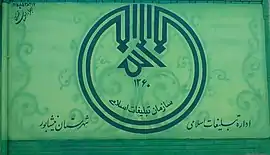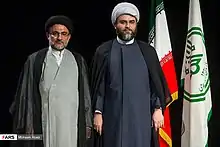Islamic Development Organization
The Islamic advertisement Organization (Persian: سازمان تبلیغات اسلامی ایران) is an Iranian religious and cultural organization.[1][2] It was created by Rouhollah Khomeini after the 1979 Revolution in Iran, and is under the supervision of the Supreme Leader.[3] This organization was originally created in the summer of 1982 to promote the ideologies of the Islamic Republic.[4]

History
It was formed after the revolution based on the decree of the 1st Supreme Leader, Ruhollah Khomeini.[5][6] in 1981.[7][8] The Organization is an independent legal entity managed by the supreme leader of Iran.[9]
Name
The initial name of the Islamic Development Organization was "The Institution of Islamic Development Council" (Persian: نهاد شورای عالی تبلیغات اسلامی). This was later changed to "Islamic Development Organization" on 3r April 1989.[10]
Chiefs

Ahmad Jannati was the first chief.[11] He was succeeded by Mahmoud Mohammadi Araghi for ten years, followed by Seyyed Mahdi Khamoushi and Mohammad Qomi.[12][13][14]
Goals
The goals of the Organization are:
- Revive and promote Islam in all needed fields, and develop Islamic ethics between people, particularly youth.
- Defend the principles of Islam, Islamic republic system, and Islamic revolution aims.
- Quantitative and qualitative development of religious promotion.[15]
Dependent organizations
- Soore University
- Mehr News Agency
- Art field
- Research Institute for Islamic Promotion and Studies, Baqir al-Uloom
- Darol-Quran al-Karim Organization
- Tebyan Cultural Institute
- Amirkabir (publisher)
- Ketab Shahr Company
- Tehran Times English-language newspaper
- Organization of Islamic Education Schools
ِDuties
21 duties were approved by the board of trustees, including:
- Policy making, planning, guidance, organizing, supporting, and supervising public religious promotion.
- Revival and development of Shia education, culture and history.
- Surveying "misleading advertising," and "cultural invasion" from political opponents.
- Co-operation within ministries, governmental organizations (and other related institutions) in order to develop Islamic education and culture.
- Founding of information centers in specialty, promotion and religious fields.[16]
See also
References
- Religious formations of "Islamic development organization" iqna.ir Retrieved 2 Feb 2019
- Islamic development organization rasanews.ir Retrieved 2 Feb 2019
- Familiarity with the Islamic Development Organization hamshahrionline.ir
- Anniversary of the establishment of the Islamic Development Organization hawzah.net
- The new constitution of Iran's Islamic development organization mehrnews.com Retrieved 2 Feb 2019
- Knowing Islamic development organization hamshahrionline.ir Retrieved 3 Feb 2019
- Islamic development organization, in a nutshell dana.ir Retrieved 2 Feb 2019
- Founding of Islamic development organization (of Iran) by the order of Imam Khomeini todaytime.ir Retrieved2 Feb 2019
- Statute of Islamic development organization rc.majlis.ir Retrieved 2 Feb 2019
- founding anniversary of "Islamic development organization" hawzah.net Retrieved 2 Feb 2019
- Ayatollah Jannati, the (first) chief of the Islamic development organization imam-khomeini.ir Retrieved 2 Feb 2019
- Hujjatul-Islam Qomi, the --new-- chief of Islamic development organization farsnews.com Retrieved 2 Feb 2019
- The Chief of Islamic Development Organization, Mohammad Qomi mashreghnews.ir Retrieved 2 Feb 2019
- New Head of Islamic Development Organization Appointed en.alkawthartv.com Retrieved 4 Feb 2019
- The new constitution of the Islamic development organization (of Iran) farsnews.com Retrieved 2 Feb 2019
- Founding anniversary of "Islamic development organization" iqna.ir Retrieved 4 Feb 2019